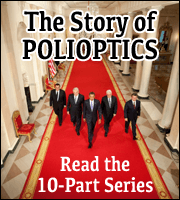I’ve watched the revival of America’s favorite political stage show every four years since 1988. After twenty-eight years of podium performances, will Philadelphia become the venue for a fabled finale?
I’m gearing up, at age 50, to attend my eighth consecutive Democratic Convention. Once a kid packing his bags for Atlanta, this time I’ll have my own kids in tow for a short trip from New York to Philadelphia. They’ll see a spectacle, starting with opening gavel on July 25, like I saw in 1988.
A more celebrated convention dinosaur who betters my streak is 69-year old Bill Clinton, who I have watched — once in a cringe-worthy performance, but otherwise masterful — at each party gathering during my adult years. As Clinton takes his next turn at the podium, the words he chooses, and the manner in which he delivers them, may never be so fraught with promise, or peril. Will he upstage his wife? Can he dismantle her opponent?
Maybe he’ll do both.
The first time I saw Clinton at a convention was his worst. I was a twenty-three year old political neophyte in the nosebleed seats at the Omni in Atlanta on July 20, 1988. Somewhere below my vantage point, in the broadcast booth of NBC News, Tom Brokaw interjected during that night’s featured speakers’ remarks. “You’re listening to the lengthy nomination speech of Governor William Clinton of Arkansas,” Brokaw told viewers. “He’s now seriously in overtime. He’s only about halfway through his prepared text and he should have been done about five minutes ago because he was scheduled to go only twenty.”
In fact, Clinton was only allotted fifteen minutes to put Mike Dukakis’s name in nomination. In an extreme case study in damage control, Clinton made his way across the country from Georgia to Burbank, California to appear on “The Tonight Show” with Johnny Carson to make amends. When the governor was introduced on set and plopped down next to Carson, the host pulled out a jumbo hourglass from beneath his desk. The audience guffawed as the steady stream of sand served as a timekeeper for Clinton’s segment, a visual deterrent to filibuster. The stunt worked, for Carson and Clinton. Johnny, with good-natured humor, validated Bill before his huge national audience, and the show hit its planned commercial break.
Four years later in New York, in 1992, Clinton was himself the closing act. He took the stage right after Linda Bloodworth-Thomason debuted her gauzy bio-film, “The Man from Hope,” a gushing paean to small town values embraced by delegates in the hall and viewers at home. The evening ended as hopefully as it began, with Fleetwood-Mac’s “Don’t Stop Thinking About Tomorrow” offering a crescendo for the convention and an anthem for the eight years that followed.
By the time the confetti fell in Madison Square Garden, I had already left Manhattan, hitting the road to ready a West Virginia stop in the steel town of Weirton, a midway point on the triumphant nine-state Clinton-Gore bus tour — choreographed by Hollywood producer Mort Engelberg — that set a new standard for crowd-galvanizing convention encores.
In advance of the convention in Chicago in 1996, Engelberg reprised his impresario role, enlisting my help on a six-state whistle-stop train tour called “The Twenty First Century Express. Our train wended its way through West Virginia, Kentucky, Ohio, Michigan and Indiana before arriving at the United Center.
There was method in our meandering: the stultifying early days of the party gathering bored the media. To keep their attention, we staged a big event each day en route, timed perfectly to broadcast live to the delegates. I found myself scrunched in the buffer right below Clinton’s podium during those rallies, cueing him whenever Chicago tuned in.
The only wart marring our production was the revelation, at trip’s end, that Clinton’s strategist, Dick Morris, had been outed for holing up at the Jefferson Hotel with a $200-per-hour prostitute named Sherry Rowlands. Morris tendered his resignation before he left the Windy City.
In the three conventions that followed — Los Angeles in 2000, Boston in 2004 and Denver in 2008 — Clinton returned to a supporting role, but never for a moment left the stage.
In L.A., where by then I was working for an internet startup covering the goings-on as a columnist, Al Gore sought to distance himself from his scandal-tinged boss. The vice president laid his family values on thick, slathering his then-wife, Tipper, with an extended open-mouthed smooch on national television, the kiss staged within feet of the live lenses.
For his part, on August 18, Clinton staged what had to be the most extended entrance in convention history as part of his White House swan song. Cameras tracked his deliberate, ninety-second march through the bowels of the Staples Center to a rapturous crowd waving placards reading “Thank You President Clinton.” Peter Jennings quipped that the walk had “a rather strange look about it,” but inside the arena, the unparalleled promenade sent the expectant delegates into a frenzy.
In Boston, my hometown, I watched the Democratic nominee, a decorated Vietnam veteran, attempt to unwrap himself from unwelcome branding applied by the “Swift Boat Veterans for Truth” with an awkward opening line, “I’m John Kerry, and I’m reporting for duty.” Kerry’s fleeting moment in the sun, shared with North Carolina senator John Edwards, was eclipsed by two Democratic eras.
President Clinton, his star slowly descending, was introduced on Monday night, July 26, by his ascendant wife, New York senator Hillary Clinton. Twenty-four hours later, a forty-two-year-old Illinois state senator sent an unspoken message — set your clocks for the Obama Era — between the lines of his classic keynote catchphrase, “There is not a black America and a white America and Latino America and Asian America — there’s the United States of America.” Twelve years later, Obama’s soaring vision remains an aspiration.
In Denver, Clinton adopted a new role for himself at conventions, as “Explainer-in-Chief.” The primary campaign between his wife and Obama, he joked on Wednesday night, “generated so much heat, it increased global warming.”
To cool things off, a grand outdoor stage set was erected at Invesco Field at Mile High, the home of the Broncos, for the nominee’s Thursday night acceptance speech. The idea was to pack the place with 84,000 people, a crowd exceeding even John F. Kennedy’s crowning moment at the Los Angeles Coliseum in 1960. But during the day, a photo of the columned proscenium, with design motifs borrowing from L.A., Soldier Field in Chicago, and the White House Rose Garden, moved on the Drudge Report, unleashing a chorus of ridicule from right wing media. Headlines mirrored that that of the Daily Mail, which proclaimed, “Obama God! Democrats build a temple for Barack.”
As the host of my SiriusXM’s radio show, “Polioptics: The Theater of Politics,” I flew to Charlotte for the 2012 convention and keep my streak alive. The threat of rain, and perhaps a display of stagecraft temperance, drove the Democrats to move President Obama’s speech from an outdoor setting at Bank of America Stadium to the cozier confines of Time Warner Cable Arena. There, the Explainer-in-Chief stole the show once more.
Clinton spoke for forty-five minutes, his voice hoarse from decades of overuse. But the delegates, a generation removed from those who clamored for him to wrap it up in 1988, still hung on every word. “We believe ‘we’re all in this together,’” he told them, “is a better philosophy than ‘you’re on your own.’” When it was over, the first man to join the speaker on stage was his onetime nemesis, Barack Obama, who enveloped Clinton in a warm embrace for the cameras — but no kiss, alas. The hug tied two Democratic dynasties together, its next chapter to be written later this month in Philadelphia.
The heir in line for the throne is Hillary Clinton, a pivotal player in each of the conventions I’ve witnessed leading up to Philadelphia, but not until now cast in the leading role. Her two top supporting actors — the husband she stood behind and the president she dutifully served, each bringing her sorrow and setback, but each supporting her with political opportunity, and both a bona fide convention superstar — must execute a delicate dance through rhetoric, body language and choreography to yield her the spotlight at last.
Hillary, vastly experienced in all facets of federal government, breaks the mold in more ways than gender. Her husband was forty-five at the 1992 convention. George W. Bush was fifty-four when Republicans nominated him in Philadelphia in 2000. Barack Obama was forty-seven when he ascended to his Greek temple in 2008.
Had Marco Rubio not stumbled into robotic repetition during his disastrous debate in New Hampshire, the Florida senator, at forty-five, might have traveled to Ohio — the other electoral vote-rich swing state — atop his party’s ticket. At his age, Rubio would fit neatly into the pattern of electing middle-aged presidents during what I chronicle in my book as “the Age of Optics.” Pitted against the younger, more teleprompter-ready Rubio, Hillary might have seemed more closely aligned with the respected-party-elder-turned-nominee who patiently waited their turn, and lost, in 1996, 2008, and 2012.
But in this pattern-breaking spectacle of 2016, there is neither script nor precedent to follow from the conventions through Election Day. A commander of policy by study, and yet an introvert by nature, Hillary Clinton faces a similarly-aged but asymmetrical opponent. If preparation for the fall debates is the qualifying factor for victory, she will have the advantage. If the voters are swayed by the size and zeal of the crowds during autumn rallies, she could find herself on the losing end of the stick to Donald Trump. Unlike Dole, McCain or Romney, this year’s GOP nominee is man whose long-nurtured celebrity and genuine on-stage charisma has brought him farther than anyone, except maybe himself, thought possible.
A year of prologue is now history. Our ability to directly compare and contrast these two aspirants for the Oval Office begins in Cleveland and Philly. The last time that the delegates of major national parties met, one gathering was marked by unity, two men hugging it out after years of rivalry, the other was marked by Clint Eastwood debating with an empty chair. These stage shows matter. This year, oddly, they matter more than ever. I can’t wait to pack my bags.
Josh King is the author of OFF SCRIPT: An Advance Man’s Guide to White House Stagecraft, Campaign Spectacle, and Political Suicide, published in April. He served in the Clinton White House from 1993 to 1997 as director of production for presidential events and from 2011 to 2014 was the host of “Polioptics: The Theater of Politics,” on SiriusXM Satellite Radio.



Leave a Reply